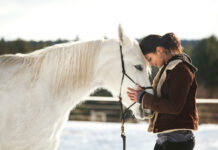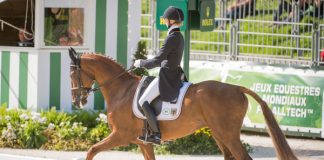Round-pen work — also known as free longeing — is used by many horse owners, but the level of success achieved varies greatly. Used properly, this form of groundwork can be a valuable tool in building a solid foundation in a horse’s training. However, if you don’t understand how to correctly handle your horse in the round pen, you can end up with problems.

Problem 1:
When I ask my green horse to walk or jog in a circle around me, I swing the end of the rope to get him to move away from me. Instead, he moves his hind end away and walks toward me. When I swing the rope to get him to move away, he ignores it. How can I get him to do what I’m asking?
McNabb’s Recommendation:
It’s not uncommon for a young horse to seek relief and comfort from you in the round pen by directly approaching you. In order to move him away, you need to direct pressure toward his head, neck and shoulder, not his hindquarters. Once you begin adding pressure to the head, neck and shoulder, it’s important that you keep a singleness of purpose in mind. You need to know what you’re asking the horse to do. Are you asking him to endlessly run around the round pen, or just to give to the pressure?
Remember that it’s important to accept the smallest try from the horse. When he gives to any pressure, even by half an inch, release the pressure and then start again. If he ignores the pressure, which in this case is from the swinging rope, you have to increase that pressure until he no longer ignores it. We frequently feel bad about spinning a rope at a horse, or even potentially spanking him with it, but if he crowded the space of a more dominant horse, that horse would bite him or kick him in the ribs with both back legs. I’m not advocating excessive use of force, but sometimes you have to increase pressure to a higher level than what you’re currently using.
As soon as he moves away, release the pressure of the spinning rope. You’re teaching the horse to move away, not making him move. The pressure motivates him to learn, but what actually teaches him is the release of that pressure. This shows him he got the correct answer.
Problem 2:
During free longeing, my Mustang turns into the fence so that her butt is always facing me. The same thing happens when I ask her to “join up” or come toward me when I turn and walk away. She’ll stay glued to the fence but will look at me with both eyes. If I try to approach her, she’ll turn her head away and look at me with one wary eye. It’s very frustrating, especially since she is 23 years old and fully broke. How can I get her to open up more to the training?
McNabb’s Recommendation:
Many horses will turn their hindquarters to you in the round pen as a matter of defense. They lock you out of their immediate presence and prepare to flee by keeping their tail pointed at you, therefore giving themselves a head start in leaving.
Your mare feels comfortable with the round pen, but she has not accepted you as a qualified leader. In order to develop a relationship with her that allows you to become the leader you need to be, you have to solve the problem in the free longeing before worrying about the approach.
If your horse will not free longe forward willingly, you need to increase pressure until she moves a step or two, and then release it. Continue this until she’s willingly trotting around the pen in both directions. Then begin asking for inside turns (the horse turning to the inside of the pen, not the wall) by moving away from her shoulder on a 45-degree angle. If the horse is moving to the left, you should walk on a 45-degree angle away from her shoulder to the left. This cuts off her path of flight but leaves an open door behind you. If your horse turns to the outside, putting her butt toward you, you need to immediately jump back and turn her to the left and ask again. The horse cannot change directions when standing still, so if she stops moving, increase pressure instantly until she’s moving again.
You should be the one determining when and where she stops. You need to become the dominant member of her herd. You may have to practice this inside turn several times before the horse begins to get it right. When she gets it right, release pressure by turning your back and walking away. Practice these inside turns until your horse starts to ask to stop while facing you. You’ll notice this start to happen when your horse begins to put both eyes on you, and when she slows down or even stops with both eyes toward you while changing direction.
Once this has happened two or three times, allow her to stop. You have to stop all forward movement yourself in order for the horse to stop reacting to your body language. Be still and wait on the horse. Once you have the horse consistently stopping and facing you with both eyes, then start to walk a slow half-circle around her. If at any point she takes both eyes off you for more than three seconds, send her away again and go back to practicing inside turns. In a few short minutes, you’ll have your horse willingly following you with both eyes all the time.
Remember, the horse is no more consistent than you are. If you allow her to look at you with only one eye, she will do it.
Technique Tips
If you follow McNabb’s advice, you can keep your horse from developing problems when you “send him away” in the round pen.
Sending away is done by creating pressure, and you can use a variety of tools to do this. McNabb prefers to use a lariat, simply because he’s comfortable with it, but you can use a lead rope, training stick or longe whip. Whatever tool you choose needs to be something that allows you to motivate the horse safely.
Many owners overlook a vital step the first time they take a horse to the round pen, says McNabb. They don’t give him time to investigate and get comfortable with the pen. He suggests turning the horse loose in the pen for five to 10 minutes without you inside, just to give him time to check it out fully. Once he’s done so, you’re ready to begin.
“Step into the pen and present yourself to the horse, but do not approach him,” says McNabb. “Using your lariat, or whatever tool you’ve chosen, ask him to move off. It doesn’t have to be at a run; he just needs to move away from your pressure and start building forward movement. As soon as he moves away, release the pressure for five to 10 seconds. Horses don’t think about time itself, just about what happens during that time.
“Increase pressure and release it until the horse will consistently trot three circles in either direction around the pen,” he adds. “Forward movement is a must before you begin trying to teach anything new. Once you have consistent forward movement, you can begin working on inside turns. Once you have those inside turns consistent, then you begin practicing outside turns, because it’s equally important that your horse moves willingly away from and toward you.
“You never want the horse to crowd you, so to move him away, step toward his eye,” says McNabb. “This emotionally ‘squeezes’ his head between you and the round-pen wall. It cuts off his direct route of flight and causes him to turn away from you and toward the wall/panel. If the horse dives in toward you, change his direction by increasing pressure and asking him again. Once you have the outside turns consistent, then go back and start mixing inside and outside turns together until the horse is consistently obeying both cues. How long this takes is not relevant. You can accomplish all of this in one session or stretch it out over weeks. Remember to focus on one small goal at a time.”
Liked this article? Here are others on natural horsemanship training:
Sacking Out with Ken McNabb
Round Pen Training
KEN McNABB is a trainer and clinician who was raised in the cowboy lifestyle and lives with his family on a working ranch near Cody, Wyo. The winner of several colt-starting competitions, McNabb offers an apprenticeship program at his ranch, as well as horsemanship clinics. His show, Discovering the Horseman Within, airs regularly on RFD-TV.
This article originally appeared in the October 2014 issue of Horse Illustrated magazine. Click here to subscribe!






This article offers some great advise for some of the problem I have with my young ones.
cool
Great tips.